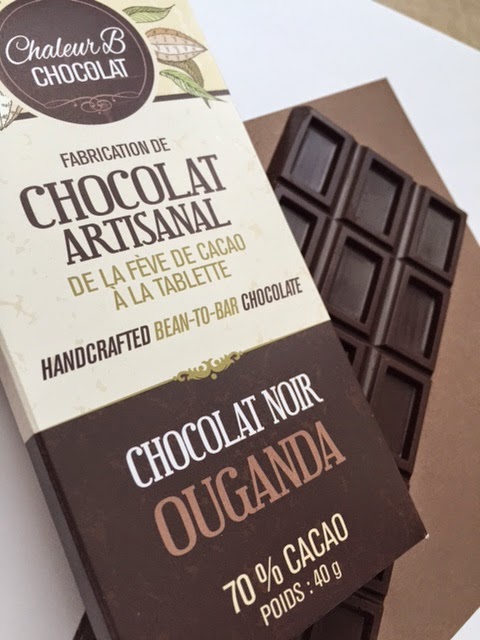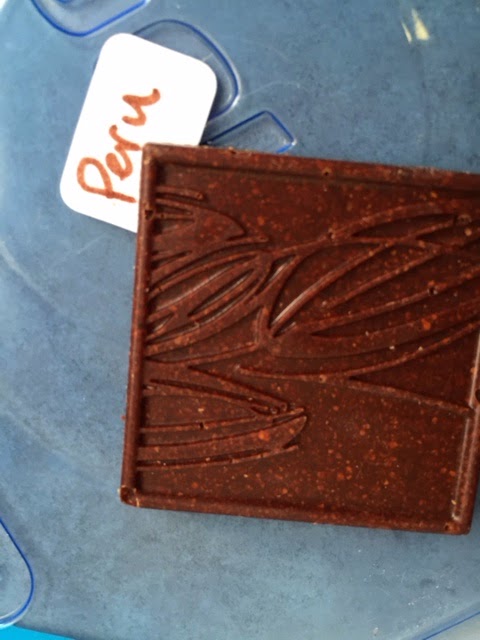 Smooth. Delicate. Buttery. These are the three words that come to mind when I think of Chaleur B Chocolat's chocolate bars. Dany Marquis, the owner of this family business that makes chocolate from bean-to-bar in Quebec, says that they do not want to rush on the volume because "quality is our priority." And a focus on quality is certainly apparent upon first taste of Chaleur chocolate.
Smooth. Delicate. Buttery. These are the three words that come to mind when I think of Chaleur B Chocolat's chocolate bars. Dany Marquis, the owner of this family business that makes chocolate from bean-to-bar in Quebec, says that they do not want to rush on the volume because "quality is our priority." And a focus on quality is certainly apparent upon first taste of Chaleur chocolate.  Dany Marquis started out in Quebec as a coffee roaster in 2005, called Brûlerie du Quai. In 2007 he took a technical chocolate training course at Weiss chocolate factory in Paris, and just recently decided to start making chocolate as a complement to his coffee business. This coffee-roaster background is similar to another Canadian bean-to-bar chocolate maker Dave Cook, who started making chocolate in London, Ontario under the Habitual Chocolate brand, after having successfully built up Fire Roasted Coffee.
Dany Marquis started out in Quebec as a coffee roaster in 2005, called Brûlerie du Quai. In 2007 he took a technical chocolate training course at Weiss chocolate factory in Paris, and just recently decided to start making chocolate as a complement to his coffee business. This coffee-roaster background is similar to another Canadian bean-to-bar chocolate maker Dave Cook, who started making chocolate in London, Ontario under the Habitual Chocolate brand, after having successfully built up Fire Roasted Coffee. I purchased three chocolate bars from Chaleur B Chocolate: a 70% Ouganda (Uganda) origin dark chocolate bar, a deep 50% milk chocolate bar also made from Uganda beans, and a 'Chocolat Blanc' (white chocolate) bar made with Madagascar vanilla beans. They arrived earlier this week and I have already made my way through most of each bar. All three were delicious.
I purchased three chocolate bars from Chaleur B Chocolate: a 70% Ouganda (Uganda) origin dark chocolate bar, a deep 50% milk chocolate bar also made from Uganda beans, and a 'Chocolat Blanc' (white chocolate) bar made with Madagascar vanilla beans. They arrived earlier this week and I have already made my way through most of each bar. All three were delicious. The reasons for their deliciousness are as I described above. The chocolate bar itself is thin, making each piece delicate so it breaks and melts in the mouth nicely. The pieces are very smooth, so clearly a good conche was done. Also, all three bars had a nice buttery texture and taste, which immediately indicated that added cocoa butter was significant in creating this overall taste experience.
Mr. Marquis told me that the Uganda cocoa beans were of the Forastero variety, a bean type not normally known for fine flavour, however these beans are very flavourful. The Ouganda 70% bar has a nice rustic, and perhaps smoky and slightly sweet chocolate flavour. The 50% milk chocolate bar is also flavourful, but has a nice, smooth profile with low acidity.
 Chaleur B Chocolat's white chocolate bar is smooth and delicious with a strong vanilla bean and cocoa butter flavour. It is sweet, but not sickeningly so in the way that commercially sold white chocolate can taste. Of all the white chocolate bars that I have tasted, this is now one of my favourites.
Chaleur B Chocolat's white chocolate bar is smooth and delicious with a strong vanilla bean and cocoa butter flavour. It is sweet, but not sickeningly so in the way that commercially sold white chocolate can taste. Of all the white chocolate bars that I have tasted, this is now one of my favourites.Mr. Marquis also makes chocolate with single origin beans from Madagascar (Ambanja origin), Venezuela (Ocumare), and Ecuador Camino Verde. For now, you can purchase the Uganda bars, the white chocolate bar and a Mokaccino bar on the website at www.chaleurb.com. Chaleur's chocolate will also be available in the coming weeks at La Tablette de Miss Choco in Montreal (http://latablette.ca/).
Here are the package details from the three bars that I tasted this week by Chaleur B Chocolat:
Chaleur B CHOCOLAT
Carleton-sur-Mer, Quebec, CANADA
www.chaleurb.com
Chocolat au Lait OUGANDA, 50% Cacao, 40g
Ingredients: Cane sugar, cacao beans, cacao butter, whole milk powder, vanilla.
May contain traces of flour, dairy and nuts.
Chocolat Blanc Vanille de Madagascar, 40g
Ingredients: Cacao butter, cane sugar, whole milk powder, vanilla.
May contain traces of flour, dairy and nuts.
Chocolate Noir OUGANDA, 70% Cacao, 40g
Ingredients: Cacao beans, cane sugar, cacao butter.
May contain traces of flour, dairy and nuts.






.JPG)







.JPG)


.JPG)





.JPG)
.JPG)


.JPG)






.JPG)



.JPG)
.JPG)




.JPG)


